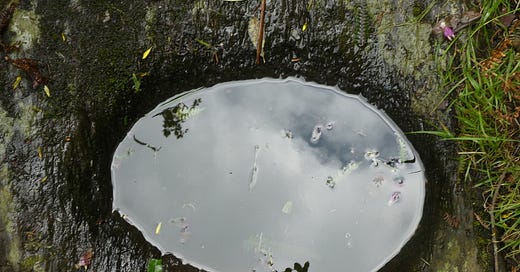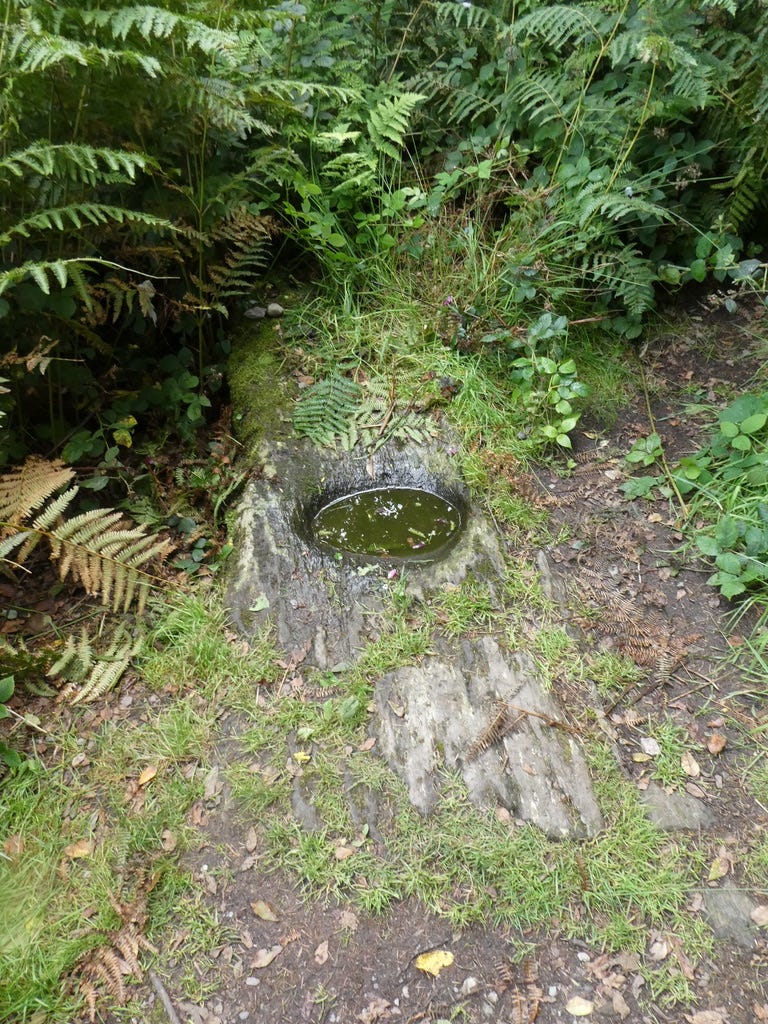The Wart Well, Castlefreke, County Cork
What makes a well ‘holy’? What makes any landscape feature ‘holy’, come to that? There might be a lot of different answers to this question. Presumably the original builders of Stonehenge or Newgrange, whoever they were, attributed a holiness or a sense of the sacred to their constructions, and/or the site on which they were built. Across the world we can find landscape features, either natural or manmade, made ‘holy’ by association with any number of different cosmologies, including that of the Christian Church.
It’s common to hear an argument, usually made by people who don’t like that Church, that Christian landscape features are somehow inauthentic: that they are all stolen from previous ‘pagan’ traditions, and bent to the Church’s will in order to replace previous traditions. This argument is especially common in Western Europe, and there’s no doubt that it is sometimes true. As I wrote in the introduction to this series, it’s estimated, for example, that around a third of Ireland’s holy wells were sacred sites before Christianity arrived on the island.
But what if such ‘appropriation’ is at root really something else: continuity? Christians, after all, were hardly the only people to continue to use the religious sites of previous cultures. We know, for example, that Stonehenge was used as a of sacred site over thousands of years, by different cultures with different beliefs. Once we get past the anti-Christian bias inherent in the ‘all Christian sites are really pagan’ narrative, I think we can see something more interesting emerging: the possibility that some places in the landscape are sacred by nature, and that people with what we might call a ‘religious sensibility’ can pick up on this, even if their religions teach them different things about the nature of reality.
This is a bit of a digression for a Sunday morning, perhaps, but it’s a question which has always fascinated me: Which came first, the holy place or the rituals conducted at the holy place? I suspect it is the first of these. Whatever the truth, some places have a light hanging over them, or emerging from within them. They are thin places. I don’t know why, but I’ve seen it time and time again.
What makes a well ‘holy’, then, might be a number of different things, including the place in which the well is situated. Traditionally in Ireland a ‘holy well’ is a spring producing fresh water, which is dedicated to a Christian saint and which is also often associated with folk cures and sometimes miracles. But not all wells follow this pattern. We have already seen a few on our travels that take a different shape. This week, deep in the woods of County Cork, we come across a type we have not yet encountered.
Castlefreke woods are named for the ‘big house’ that was built in them by the unfortunately-named Freke family in the eighteenth century. Burned in the 1920s, the semi-ruins were later used as a military hospital during World War Two (or ‘the Emergency’ as it is euphemistically known here) before being dismantled in the 1950s. The tale takes an unusual turn at this point though: rather than falling back into the ground, as so many other big houses have done, the castle was bought in 2005 by a descendant of the Freke family, who is apparently restoring it.
These days it looks like this:
You won’t get near the castle if you go walking in the woods at Castlefreke, though. It’s heavily fenced-off and guarded by ‘no trespassing signs.’ Plus ca change. Still, we well-hunters have no interest in such flummery anyway. It’s the waters we have come looking for.
And soon enough, deep in the woods, at the end of a bracken-clogged trackway, we find them:
You’ll notice a lack of rag trees, statues, offerings, crosses, signage or anything much at all around this well. Get close to the water and you’ll notice a lack of something else too: an obvious water source. That’s because the source here is not below ground, but above it. This well is a curiously circular, and surprisingly deep, hole in the rocky ground, which is filled up by the rain.
What we have here, my fellow explorers, is a bullaun.
Bullauns are found all over Ireland, and like Stonehenge or Newgrange they are an ancient mystery. A bullaun, in simple terms, is a deep hole in a slab of rock. The name comes from the Irish word Bullán, which means ‘bowl.’ Quite what they are, though, and where they come from, when they were made, if they were made (or are naturally occurring) - most of all what they were for: all of this remains a mystery.
All we really know about bullauns is that they appear to be very old indeed, and are to be found all over the island. Most often they are associated with Christian sites, but it is not clear what Christian remit they might have. Some of them were certainly used as baptismal fonts, but this was probably not their original purpose. What that purpose quite was will never be known. Perhaps it was religious: they could have been vessels for holy water, or even the bases of rotating preaching crosses. Perhaps it was purely practical: they may have been used for grinding grain, or (my favourite theory) they may have been acorn-pounding devices dating back as far as the Mesolithic. Here you can see a great selection of photographs of many different bullauns, along with some speculation about their possible origins and use.
What about the Castlefreke bullaun, then? This has a sacred and a profane purpose rolled into one, as so many of our wells do. It has long been regarded as a ‘holy well’ but it has no saint and no series of rounds. Rather, it offers a miraculous cure - in this case for warts. ‘Wart wells’ of this kind are the second-most common type of healing well in the country, the most common being the ‘eye well.’ Dip your warty parts three times into the water here and a cure, it is said, will be forthcoming.
I have no warts, thankfully, so was not able to test out the cure offered by this ancient bullaun. But I was able to rest a while in the green glade and wonder how long this stone has inhabited this place, and how long this place had been holy, and to whom. We will never know; but then, we don’t need to. Some things should remain a mystery.








The idea that some places are holy is important. We are I think moving away from that idea that the world is just inert stuff. We can begin to recognise that culture and psychology are inadequate anthropomorphic explanations. We can really say this is beautiful, this is scary, this is awe inspiring, this place is holy without meaning that it is all in the eye of the beholder. The world suddenly becomes a richer and far more interesting place.
I completely agree with your opening section, of course. In many places, Christians (usually directly disobeying their priests and bishops) continued to honor the old agreements the pagans had made with the spirits of place.
And of course, there were multiple waves of purifiers who would destroy those sites to uproot these continuations. The fact that puritan iconoclasts targeted holy wells and standing stones is extremely important for understanding how capitalism and our “machine age” came about, though of course they were hardly the first.
I have a radical proposition for you, which is the unstated core of my argument about religion and the machine. You get to be the first person to hear it.
By continuing those agreements (though often begrudgingly at best) the Church (both Orthodox and Catholic) kept the relationship between humans and the spirits stable for centuries. The Reformation in Europe was the end of that stability: the church self-purged in response to the reformers’ accusations, both sides abandoning those agreements.
What came next was the age we are in now, the capitalist/secular/machine era, and it was born from the end of those agreements and man’s belief he could master all of nature (and its spirits and forces).
A Christianity that re-establishes those agreements could help stabilize the world, which is why I respect your work so much as a pagan. Also, you’ll have much of Christianity itself against you in this work, or at least the Christianity of the last four hundred years, the one that has named all spirits as evil…